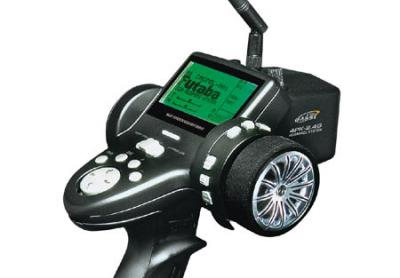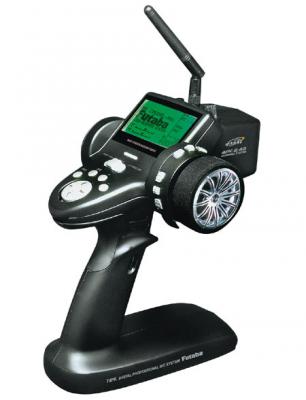Futaba 4PK 2.4GHz Radio System

The Futaba 4PK was only just released and drew a lot of attention from racers due to its rather unique look. The 4PK’s contemporary styling is not only unique, it’s extremely well balanced and ergonomic and because the transmitter only weighs 1.5 pounds, you won’t worry about hand fatigue all the way through a grueling main. Besides the repositionable wheel, you can also adjust the trigger location to fit your finger and programming pluses include 40-model memory, 12-character naming, super-sensitive 2048 resolution and a 4th channel that’s ideal for adjusting front and rear brake bias in monster trucks. And here’s the best part: the 4PK was designed from the beginning as a spread spectrum system, which means the 2.4GHz module is built in, a state-of-the-art receiver is included, and all of the incredible advantages of FASST system technology are at your command!
Click here for the full details…
Features
– Much consideration went into the design of the 4PK’s grip, which is slightly thicker to accommodate larger hands. Besides being lighter, the transmitter’s weight is well balanced for added comfort.
– Achieve perfect “feel” in seconds with the Advanced Positioning Adapter. You can drop the wheel down, move it left or right, even change the angle – a feature many drivers have requested.
– The trigger position can also be shifted by as much as 7 mm. This allows you to customize the radio for sharper response based on finger size.
– The redesigned keypad features a large 4-direction jog button for quick access and scrolling. Important functions can be assigned to buttons on the wheel housing to keep them within easy reach.
– Not only is the backlit LCD screen large enough for easy reading without eye strain, it’s also angled for instant viewing without having to tilt the transmitter.
– Because the 4PK was engineered from the beginning for 2.4GHz modulation, there’s no long, unwieldy antenna. Instead, the antenna is shorter and lighter in weight, folds down for easy storage, and pivots for optimum reception.
– No NiCd battery here – the 4PK comes with an 1700mAh NiMH pack that’s comparable in size, but with almost twice the capacity. That means about TWO HOURS of operation on a single charge – enough for the longest of mains and maybe even an entire weekend of racing!
– The included R604FS receiver features Dual Antenna Diversity (DAD) for reliability and security. Its compact size (1.54 x 1.02 x .55 inches) and weight (0.49 ounces) lets you use it in the tightest installations.

4PK System Overview:
– 40-model memory
– 10-character model naming
– 4th channel for brake bias, throttle adjustments, etc.
– 2 programmable mixes
– Assignable button, trims and dials
– Digital trims and dials
– Advanced Positioning Adapter (APA)
– Adjustable trigger location
– Backlit 128 x 64 white LCD screen with adjustable contrast
– Subtrims, servo reversing and EPA on all channels
– Fail safe
– DSC (Direct Servo Control)
– Exponential & Adjustable Servo Speed (Steering/Throttle)
– Up/Down, Lap & Systems timers
– 100-lap memory
– ATL (Electronic & Mechanical)
– Traction Control/Acceleration Rate
– ABS braking system
– Boat mixing
– Idle-Up
– Tx NiMH and Dual-Output Charger
4PK Specifications:
– “New Driver”, “Race-Ready”, “Expert” and “Big Car” menus that add functions based on driving skill level and experience
– Throttle Mode Select, for selecting acceleration/brake servo neutral points between 70/30 for nitro or 50/50 for electrics
– Vibrating alert system
– “Direct Select” single-button access to eight preassigned functions
– Navigation Lap Timer that sounds when target lap time is exceeded
– Servo Display Screen shows set-ups/mixes for individual servos (Expert Menu)
– Throttle programming options, including 5-point curve, Expo and VTR
Source: Futaba [futaba-rc.com]






